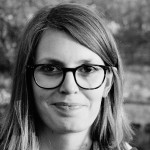The project
Alex, the small dot, and Lilani, the little line, together have created a learning aid that introduces pre-school blind or visually-impaired children as well as their sighted friends and relatives to Braille.
Starting point
Sighted children of pre-school age discover typographic signs and symbols every single day and are confronted with writing in a wide variety of situations and ways, either on their own or accompanied by adults. If stories are read aloud to children, sighted children have the advantage that they can actually see the letters and in time, usually before they even start school, they are able to identify or even reproduce one or two of them. This is not possible for blind children in this form or with such variety, because they rarely encounter Braille in their surroundings, and most of the books that are read to them are not published in Braille. This means that blind children are much less likely to come into contact with writing before they start school, and this contact is generally never accidental. This is a significant disadvantage compared to their sighted comrades. These circumstances, and the fact that there are no specially designed learning aids that allow both blind and sighted children of pre-school age to learn to read together, either in educational institutions or through easily accessible books, gave rise to the idea of an inclusive learning aid.
From the idea to the project, 2010 - 2011
The first time Fabienne Meyer had anything to do with sensitising the sense of touch of blind children of pre-school age was when she helped design a tactile book in collaboration with Petra & Vivian Aldridge (teachers for the blind) during the preparatory design course at the Basel School of Design (2003/2004). This was then followed by the first research project “Joint the dots” which brought together the current team. The goal of the BFH (Bern University of Applied Sciences) research project “Joint the dots” was to investigate the basics of designing exercise and teaching aids to help sensitise the sense of touch at a pre-school age for blind and visually-impaired children, and at the same time involve their sighted siblings, parents and friends in the learning process. At that time, there was no theoretical and practical evidence underlying the design. The prototype developed in the research project was intended to prepare the children playfully for the next step, learning Braille, and to sensitise their fingers for shapes, materials etc. The results of this preliminary project were used in the 2013 SNF (Swiss National Science Foundation) follow-up project “Punkt, Punkt, Komma, Strich” (dot, dot, comma, dash).
The SNF research project, 2013 - 2015
The SNF research project of the Bern University of the Arts HKB (CH) and Heidelberg University of Education (D) resulted in a concept for a suitably designed series of educationally and didactically sound teaching aids in nine volumes, of which two evaluated prototypes were presented at the end of the project. These two volumes “Alex und die Reise zu den Musterinseln (Alex and the journey to the pattern islands) and “Alex im Land der Unterschiede (Alex in the land of differences) help prepare sighted, visually impaired and blind children to learn to read through colourful and tactile exercises, embedded in action-based stories (insight into the structure of writing, getting to know textual elements, differentiation between perception processes etc.).
Evaluation and results of the SNF project
The evaluation of both prototypes clearly showed that the teaching aid for blind, visually impaired and sighted children is very stimulating, the content of the stories is appropriate and the children were easily able to complete the search and touch exercises. Special mention should be made of the overall positive feedback from the parents of sighted and visually impaired children. They were particularly impressed by the mixture of an attractive visual design in combination with the tactile content. The teaching aid therefore illustrates concrete possibilities for inclusive teaching and learning situations that lead to important stimuli for a scientific discussion of inclusion. The design follows the “Universal Designs” concept, which also happens to be an element of the UN Convention on the Rights of Persons with Disabilities.
The follow-up project and production, 2018 - 2022
The remaining seven volumes were developed further in 2018 by the existing team on the basis of these two prototypes with the financial support of various foundations, above all the Gebert Rüf Foundation.
Since the printers who were originally chosen to print the Braille went bankrupt due to the corona pandemic, and as a result of the ongoing shortage of raw materials, production of the booklets was delayed for almost two years. The technical demands for this type of printed matter are exceptionally high, so following countless tests and evaluations of numerous printers both at home and abroad, an adequate solution was eventually found at the beginning of 2022 in the Canton of Bern. The first edition of all of the booklets has now been printed with 1,000 copies.
The inclusive series of learning aids «Join the dots: Alex and Lilani discover the world of letters»
The booklets are compatible with general didactic requirements as well as the specific requirements of blind and visually impaired people for a modern, activity-oriented process of learning to read. The main protagonists in this new series of learning aids are Alex, a life-size Braille dot, and Lilani, a small line. The characters are integrated in action-based stories that are suitable for children, where they explain Braille and normal print on the basis of visual and haptic tasks. Each double page forms a text/image or tactile exercise unit. So as to be able to guarantee an economic production of this series of learning aids, the emphasis was on integrating aspects to support learning to read with opportunities for initial action within the text, and not necessarily on an extensive collection of material. However, each volume comes with instructions and suggestions for appropriate games and exercises for parents and significant others reading aloud or along with the children to ensure that the variety of materials and activities necessary for sensitizing the sense of touch can still be provided.
Outlook
The next stage of the project will involve the production of a French and English version of the learning aid. The association is in search of project and funding partners for development, production funding as well as distribution. The project team welcomes all contacts from interested organisations.
The project is supported by: Schweizerischer Nationalfonds (SNF), Gebert Rüf Stiftung, Ernst Göhner Stiftung, Ursula Wirz-Stiftung, Paul und Charlotte Kniese-Stiftung, Burgergemeinde Bern, UBS Stiftung für Soziales und Ausbildung, BEKB Förderfonds, Däster Schild Stiftung, Migros Kulturprozent, HKB AG Publikationen, Stiftung «Perspektiven» von Swiss Life, Vergabungsfonds Schweizerische Mobiliar Genossenschaft, Schindler Aufzüge AG, Fischer Papier.
We welcome donations.
Thank you for your valuable contribution!
Berner Kantonalbank AG
IBAN: CH45 0079 0016 9396 4671 2
Verein «Punkt, Punkt, Komma, Strich»
Schläflirain 9
3013 Bern
The people behind the project
Fabienne Meyer
Design researcher and visual designer
She is a Visual Designer (FH) and has been working as an artistic and research assistant at the Institute of Design Research in the Social Communication Research Unit at HKB since 2009. The first time she had anything to do with sensitising the sense of touch of blind children of pre-school age was when she helped design a tactile book in collaboration with Petra & Vivian Aldridge (teachers for the blind). Fabienne Meyer then delved deeper into this topic by founding the BFH research project “Join the dots” (2009-2011) and was in charge of the SNF project “Punkt, Punkt, Komma, Strich” (2013-2015). As the project manager, Fabienne Meyer is responsible for not only coordinating the briefings for the prototypes but also for designing the exercises and incorporating these in the action-based stories, as well as for their content and presentation.
Prof. Andréas Netthoevel
Graphic designer and research lecturer at the Bern University of the Arts
He is a graphic designer and has been a lecturer for visual communication at Bern University of the Arts since 2000, and a research professor since 2012. He founded the “2. stock süd” design office in Biel/Bienne in 1990 and remains its Co-Director. In the PPKS research project, Andréas Netthoevel is responsible for the overall management of the team. He is also in charge of theoretical and practical design aspects, expedites the production technology research and clarifications and is instrumental in the design process for the learning aid.
Martin Gaberthüel
Graphic designer and academic assistant at the Bern University of the Arts
He is a graphic designer, has worked at the Institute of Design Research in Social Communication Research Unit at HKB since 2010 and is co-owner of the “2. stock süd” design office in Biel/Bienne since 1995. Apart from his collaboration in the BFH research project “Join the dots”, Andréas Netthoevel and Martin Gaberthüel developed the new corporate design for the Bern Centre for Blind and Handicapped Persons. The overall design concept received several international awards, most recently the “red-dot-award best of the best” from the North Rhine-Westphalia Design Centre. In the PPKS research project, Martin Gaberthüel is responsible for the overall and detailed design and for preparing the print data for production.
Prof. Dr. Markus Lang
Professor of Education for the Blind and Visually Impaired at the Heidelberg University of Education
He is a teacher for the blind; since 2005 he has been Professor of Education for the Blind and Visually Impaired at Heidelberg University of Education. As part of his dissertation, he developed novel materials for blind and severely visually impaired children to prepare them for learning Braille. As co-applicant, he writes the learning and teaching scenarios, supervises evaluation in the field and presents the scientific performance of the project.
Frank Laemers
Academic assistant at the Heidelberg University of Education - Pedagogy for the Blind and Visually Impaired
He is a member of the academic staff at Heidelberg University of Education in the Education of the Blind and Visually Impaired: Didactics and Pedagogy Teaching Unit of the Institute for Special Needs Education (focus on learning with a visual impairment). His research concentrates on low vision in childhood and adolescence; seeing – visual perception – cerebral visual impairment and early support for children with a visual impairment. In the PPKS project he is responsible for structuring the educational content and jointly responsible for evaluating the prototypes.
Sarah Adams
Academic staff member and doctoral candidate at the Heidelberg University of Education - Education of the Blind and Visually Impaired
Sarah is a special educational needs teacher in the fields of blindness and visual impairment as well as hearing. A research assistant in the PPKS-3 project and currently completing a doctorate on the topic of early support in the education of the blind and visually impaired at Heidelberg University of Education. In the PPKS-3 project she was responsible for the pedagogical/didactic research to develop volumes 2 and 4-9. There is also a cooperation with the kindergarten of a special needs school and counselling centre under the visual impairment funding priority so that the exercises that are developed can be tested, evaluated and adapted where necessary. Sarah Adams planned, performed and evaluated the work that this involved.





